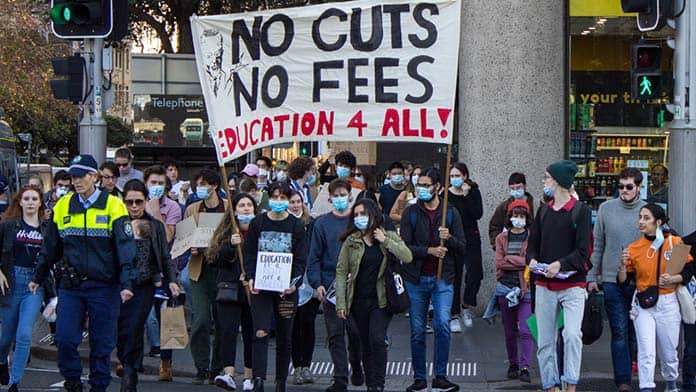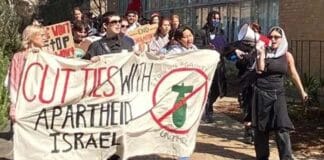Solidarity Sydney Student Position Paper
Cuts are raining down in universities across the country. Morrison has passed his Fee Hike Bill.
The campaign at Usyd has shown it is possible to fight. Hundreds have mobilised repeatedly in the face of police repression. Students have gone on strike, invaded the Vice-Chancellor’s building, petitioned, passed motions and protested. Courses, jobs and hours have been won back.
But this is only the beginning of the disaster that is unfolding across unis. The passage of the Fee Hike bill shows we are going to have to strengthen the movement to confront the attacks.
Capitalism is in crisis. COVID-19 lockdowns and border closures have created an economic disaster. Scomo’s budget makes it clear that the Liberals want students, workers and the unemployed to bear the cost. They want to cut unis, JobSeeker and JobKeeper. Meanwhile the rich get tax cuts, hand-outs, and subsidies for planet destroying industries.
Lockdown has bolstered the power of the state. Resources have been poured into racist policing and repression of protests rather than best practice health measures to control the virus.
At Usyd we see a microcosm of the Liberals’ agenda pushed by Vice-Chancellor Michael Spence. Hundreds of casuals have already lost their jobs, hundreds more jobs are threatened by voluntary redundancies and Med Science faces a ruinous restructure that is a sign of things to come. And this is despite the uni projecting a surplus.
The corporate uni
The VC is ramming through cuts there is no financial justification for. This decision is a product of the corporatised uni system. Uni was free until the late 1980s, when the ALP introduced the “Dawkins Reforms”, holding down government funding and forcing students to pay fees. At the same time they gave corporations huge tax cuts. Making up the funding shortfall meant squeezing extra money out of staff and students by charging more, making less staff do more work and degrading quality.
CEO-like Vice-Chancellors were parachuted into unis, given massive executive power and paid huge salaries. They see cuts as a way to increase efficiency, and the pandemic as an opportunity to do what they wanted to do anyway. At Usyd, some cuts such as those in Medical Science were already planned before COVID-19 hit.
The fight ahead
We must oppose the fee hikes and cuts in funding and the tightening up of HECS eligibility, as part of the fight for free education, build the fight for every job and against every cut and build the power to take on the corporate uni and capitalism as a whole.
It is absolutely indisputable that mass action—and disruption of business as usual—are crucial elements of a winning strategy. Because the cuts are the product of a deeply rooted corporate logic it is not enough to simply express our opinion. We have seen this with the passage of the Fee Hike Bill. The Liberals and management will have to be forced back. In 2012 half of the academic jobs under threat at Sydney Uni were stopped by mass marches, occupations, student strikes and blockades. Similar tactics helped save Sydney College of the Arts from complete closure in 2016. In Quebec in 2012 hundreds of thousands of students went on strike for months against fee hikes, forcing the government to repeal the laws.
A strategy for the fightback
Mobilising hundreds on September 16 and September 23 was a real achievement given the crackdown on the right to protest and the reduced numbers of students on campus.
Systematic mass building amongst students was essential. September 16 cemented a base of active support on campus that was mobilised again on the 23rd. On September 16 in total around 25 classes passed motions supporting the strike and hundreds signed a petition against the cuts. This took hour upon hour of conversations, stalls, contacting and lecture bashing to achieve.
The fact that both the September 16 and September 23 actions were built as de-centralised protests also encouraged maximum participation, given hypocritical police restrictions and genuine concerns about COVID-19 amongst staff and students.
We need to build more power, and the beginning of student strikes that we saw on September 16 showed the way. Almost 120 voted to strike in a student assembly in the lead-up, two classes voted to move so they could join the action, and another six adopted a position of “no penalty” for groups of students and individuals who left class to participate.
Another real strength was the organisation of department and faculty contingents. These established organisation beyond the existing left and connected the big protests to important localised fights around the uni. The Law students’ contingent grew from five on September 16, to 19 on September 23. Medical Science students and staff mobilised for both actions, drawing attention to the cuts they are facing. Philosophy, Linguistics, Government and IR, History, Art History, Architecture, Political Economy and others have also mobilised.
But it is a real challenge to build bigger, more disruptive and politically sharp actions in the circumstances, and there are real weaknesses we need to assess. On September 16 two classes actually voted to strike, but when the day came only individuals walked out. A significant number of students who registered for the September 16 action didn’t participate due to the police crackdown or left quickly as a result. The scale of the organising should also be put in perspective. The 2012 job cuts campaign at Usyd had the forces to gather 4000 signatures in person, last year the climate strikes saw 90+ motions passed in lectures. The is significantly more than what the cuts campaign has done so far.
We need to bridge this gap with patient argument, the right response to police repression and by building wider awareness and collective solidarity. The police crackdown is a serious issue. One activist has been charged and dozens issued with a total of around $40,000 worth of fines.
Unfortunately, the September 23 action (that became a centralised rally) consolidated a sentiment amongst sections of the student left that maximum “defiance” is the strategy we need. The Socialist Alternative motion regarding the upcoming October 14 protest called for “a defiant centralised rally” that will “march on the road”.
We do need to be willing to defy police when necessary, and have done so repeatedly. But when it becomes a caricature, the “defiance” approach amounts to a false strategy for change whereby the courageous actions of the most radical minority supposedly provoke wider layers of people into action. At worst, this can lead to self-congratulatory elitism that prioritises a small minority attracting fines above building the radicalism of the thousands who oppose the cuts but are currently being consigned to the position of bystanders.
Actions this week
We need to re-orient away from this mistaken, elitist strategy to build the kind of power we really need to win.
This week there are two actions in response to Morrison’s budget and his vicious attack on universities, students and staff.
First, there was a 60-strong NTEU (National Tertiary Education Union) staff protest in Victoria Park on October 13. This was organised openly through the submission of a Form 1 (a form notifying police of a protest).
Police took the NTEU to the Supreme Court to stop the protest but the union won in court on Monday. This is an important crack in the use of COVID regulations to ban protests.
The second action is the student protest with staff support under the guise of a “teach-out” on the Quad lawns on October 14.
It was important to build the maximum student turn out for October 14 by mobilising all the faculty and department networks and hitting lectures. But we must recognise that it would have been far better to have the widest possible student walk-out and one joint, post-budget action uniting students and staff, if necessary negotiated around a Form 1 like the NTEU demonstration.
Students could have argued to shut down classes so both staff and students could attend a united rally, just as we did in the climate strike last year. Staff and student mobilisations can reinforce each other.
This would have been an important step in a context where the fee hike bill has passed and hundreds of NTEU members involved in National Higher Education Action Network have voted to support industrial action to defend higher education.
But the trajectory towards “defiant” minority actions meant any effort to organise class walkouts or another student assembly was abandoned, and some in the campaign were uninterested in working to organise a joint action with the NTEU, preferring to simply use a staff teach-in as cover for a student event.
This strategic weakness was only exacerbated by a lack of representative, in-person organising meetings and accountable campaign organisation. Student activists voted on events like the “staff-student forum” last week only to have it cancelled without any explanation. There was no clear delegation of responsibility for organising key aspects of the October 14 action, leaving it to the self-appointed. Zoom meetings of the Sydney Uni EAG are often stacked and unrepresentative and there is non-transparent control of infrastructure, chairing and decisions by the unelected.
We need democratic meetings where students outside the existing left can come, genuinely contribute and take real ownership of the campaign in maximum numbers. Addressing this is a key task if we are to build a sustained mass movement.
Next steps
There is time for one more major mobilisation this semester. In the wake of the budget and the passage of the fee hikes bill, the localised fight against huge job cuts at Usyd will be more important than ever. There has to be a widely advertised, Sydney Uni specific, in person meeting early next week to debrief and discuss what our next action could look like.
There also has to be close attention to localised fights in departments and faculties. Students and staff have been organising in Med Science against massive proposed cuts. The next phase of these cuts being finalised is fast approaching. Over 220 have signed a petition, dozens have participated in a photo petition against the cuts and Med Sci staff and students have mobilised for protests. Students have also shared statements about how the cuts will impact them and Postgraduates who will lose their supervisors have also been campaigning. There must be further actions around Med Science, and the fight should be a feature of any larger actions.
There are also looming cuts to student learning support which will hit international students particularly hard. Many students already face wait times of six weeks or two months when they try to book an appointment for assistance with their essays. This is something to watch as details emerge.
Localised resistance delivers. In late September Conservatorium Executives decided to cut the Jazz Course by 33 hours. This cut was reversed after a petition and collective pressure from students. The win followed a series of small protests and meetings about cuts at the Con in Semester one. Every small fight creates sparks of resistance that can spread.
After going all out for the actions this week, we must re-group and organise next week, fan every small battle and prepare our next blow against the corporate uni imposed on us by Spence and Scomo. There is a battle on for the future of our unis and our society. We need to organise, fight and win.






